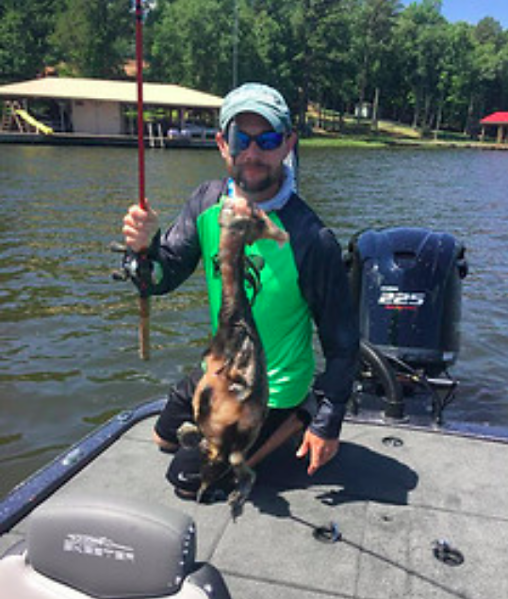Feathers in live well; bass swallows duck
Published 9:36 am Thursday, May 25, 2017

- CLAY MARTIN/Courtesy JAMES QUALLS FISHED OUT what was left of a bird that was regurgitated by a bass in the live well. The bass was caught by Clay Martin during a tournament on Lake Tyler.
It was a good start to the morning in the Fishers of Men tournament on Lake Tyler for Clay Martin and James Qualls. The fishermen were expecting a topwater bite and that is what they got.
Concentrating on the shallow water bite the tandem boated a number of keepers early including one that went 4 to 4.5 pounds.
“It blew up on a topwater frog,” Martin said.
As quickly as they measured one bass on the belly board they put it in the live well and kept fish.
“We caught a limit pretty early, About 10,” Martin recalled.
Their next keeper was a good fish. Big enough to cull one of the smaller bass they caught early. That was when the morning went from another day on the water to something a little bizarre.
“My partner opened the live well and asked, ‘What is in the live well. There is feathers and stuff in here,'” Martin said of the moment Qualls went to exchange fish.
Digging around in the live well Qualls eventually discovered the source of the feathers.
“There was a duck in there that one of the bass had spit up,” Martin said. “He took his hook and fished it out of the live well. The duck was a foot long. It could have been a mud hen or a young mallard or a wood duck.”
Judging by its feet, it could have also been a cormorant, which would have been the ultimate in irony since they are known for eating bass.
An occasional duck hunter, Martin said what remained of the bird was about the size of a teal, one of the smallest ducks weighing in at most at 13 ounces, fully feathered.
“I have had them spit up shad and different stuff like that, but this was the first time I ever saw one spit up a duck,” said Martin, who helps put on an every other Friday night jackpot team tournament on Lake Tyler.
In Texas lakes largemouth bass are apex predators. When they are feeding it is not unusual for a fisherman to catch a bass with baitfish in its mouth or another lure it had recently stolen from another fisherman.
And every fisherman has seen a bass floating on the surface with another bass so large it could not swallow it stuck in it mouth.
Baby birds, especially ducklings and goslings swimming across a lake are often targets for a bass. As are snakes.
Every once in a while bass fishermen take advantage of this situation. Alabama angler Aaron Martens became probably the most famous example when he won a 2015 Bassmaster Elite Series event on Lake Havasu, Ariz., by fishing a vegetated shoreline where he had seen bass feeding on baby blackbirds that fell out of their nests.
During the tournament Martens caught the majority of his fish in the vegetation using a rig he concocted to simulate a bird in the water.
“I do that all the time. I don’t know why people don’t believe me when I say it. The birds fall out of the nest, and the bass eat them. Birds are definitely part of their diet,” Martens reportedly said after the tournament.
He added that previously during a tournament in California he had one spit up an entire black bird.
Craig Bonds, Texas Parks and Wildlife Department Inland Fisheries Director, did graduate school research on the seasonal diet of a variety of sportfish species including black bass on Claytor Lake, Va.
“I found that largemouth bass had the most diverse diet of all sportfishes in the reservoir that I sampled,” said Bonds, who analyzed stomach contents of smallmouth bass, spotted bass, striped bass, hybrid striped bass, and walleye. “The diversity of prey items and sizes of items consumed is likely a result of the larger gape width for largemouth bass and the fact that this species at times occupies shallower, near-shore areas where a greater diversity of prey items can be encountered.”
Bonds said the most common items coming out of the largemouth bass were sunfish, shad and crayfish.
“However, I found a wide variety of items, including other bass, invertebrates including many kinds of insects – both aquatic larvae and adults, reptiles including small turtles and water snakes, frogs and small unidentifiable birds,” Bonds said.
Not surprising he also found discarded soft plastics baits. Something that is a concern because they don’t break down. There was one case in which the fish consumed the whole hog of soft plastics as it were.
“I examined one largemouth bass that contained what appeared to be a whole package of soft plastic worms in its stomach. There were a dozen or more of the exact same style and color plastic worms. The most plausible explanation I can think of is that a package of worms blew out of an angler’s boat and sank to the bottom, where the fish swallowed each one at the same location,” Bonds said.
For Martin and Qualls, their bird pattern did not turn out to be a winning formula. With the bass having spit out the bird it may have knocked them out of the money.
“It went from about 4 pounds to being around 3. We ended up a few places out of the money,” Martin said.
– Have a comment or opinion on this story? Contact outdoor writer Steve Knight by email at outdoor@tylerpaper.com. Follow Steve Knight on Facebook at Texas AllOutdoors and on Twitter @txalloutdoors.






